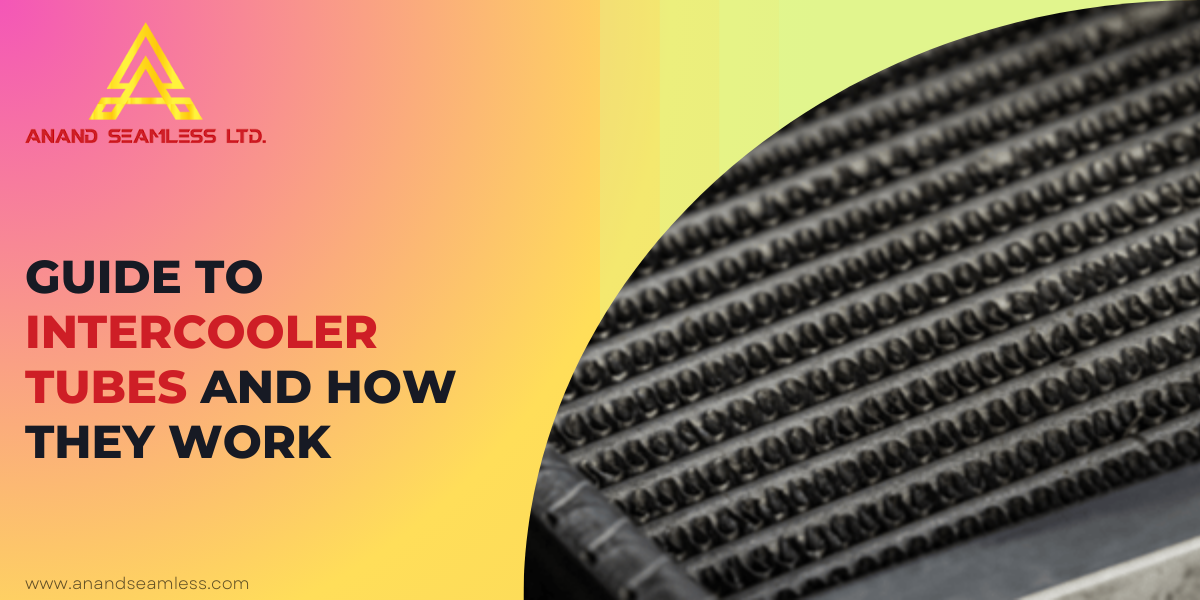Quick Inquiry
Intercooler tubes play a critical role in modern industrial and automotive systems by facilitating efficient cooling. Especially in high-performance applications, such as in automotive, heavy machinery, and aviation industries, intercooler tubes help manage the intense heat generated by the engines and compressors. By lowering the temperature of compressed air entering the engine, these tubes enhance both the engine’s performance and its lifespan.
As businesses and industries seek to boost their equipment’s power without compromising on efficiency, intercooler systems with advanced tubing designs are increasingly in demand. In this guide, we explore the essential aspects of intercooler tubes, how they work, and their integration into broader intercooler systems.

Types of Intercooler Tubes
Air-to-Air Intercoolers
Air-to-air intercoolers are commonly used in high-performance and commercial vehicles due to their simple, effective design. In these systems, the intercooler tubes carry compressed air from the turbocharger or supercharger. As the hot air passes through the tubes within the intercooler core, outside air flows over these tubes, dissipating the heat from the compressed air.
This setup has several advantages. Primarily, air-to-air intercoolers are known for their durability, as they do not involve water or other liquids that might lead to leakage or corrosion issues. Their maintenance is relatively straightforward, and they perform effectively under most driving conditions. However, their performance can be limited in extremely high temperatures or when space is a concern, as they require large airflow for optimal cooling.
Air-to-Water Intercoolers
Air-to-water intercoolers are the preferred choice in setups where compact design and high cooling efficiency are necessary. They work by using water as a cooling medium rather than direct air. The compressed air passes through the intercooler tubes, which are surrounded by water that absorbs and removes the heat. A separate radiator or cooling circuit is then used to dissipate the heat from the water.
Air-to-water intercoolers are highly efficient in terms of cooling and are frequently used in motorsport and industrial applications where extreme cooling is required. They can deliver consistent cooling even in high-temperature environments and limited spaces. However, they involve a more complex setup with additional components, such as water pumps and separate radiators. As a result, they require regular maintenance to prevent issues like leaks or water pump failure.
Components of an Intercooler System
An intercooler system comprises several key components, each playing a vital role in effective heat dissipation. Let’s look at these components in detail.
Intercooler Core
The intercooler core is the main section where heat exchange occurs. This core, typically made of aluminum, contains intercooler tubes that carry compressed air. The design of the core is critical, as it must maximize surface area for optimal heat transfer while maintaining structural strength to handle high air pressure.
Intercooler Tubes
Intercooler tubes form the pathway for compressed air within the core. These tubes are engineered to withstand high temperatures and pressures, allowing efficient heat transfer from the compressed air to the outside cooling medium, whether air or water. Their design varies based on the intercooler type, but they are typically made from high-strength, heat-conductive materials like aluminum or stainless steel.
Heat Exchanger and Airflow Ducts
The heat exchanger is responsible for dissipating the absorbed heat from either the water or the air that flows around the tubes. In air-to-air systems, external airflow ducts are also crucial, as they direct the ambient air over the core to cool the tubes. In air-to-water systems, the heat exchanger is typically a separate radiator that releases heat from the water circulating through the system.
How Intercooler Tubes Work
1. Air Is Compressed
When air enters the turbocharger or supercharger, it is compressed, causing its temperature to rise. This heated air has a lower oxygen density, which negatively impacts combustion efficiency.
2. Hot Air Passes Through Intercooler Tubes
The hot, compressed air flows through the intercooler tubes, which are designed to cool it down before it enters the engine. The cooling process is essential for improving air density.
3. Air Is Cooled and Becomes Denser
As the air travels through the tubes, it either passes through external airflow (in air-to-air systems) or is surrounded by cool water (in air-to-water systems), lowering its temperature. This increases the air’s oxygen content, making it denser.
4. Cooler Air Enters the Engine
The now-cooled, denser air enters the engine, where it mixes with fuel for combustion. This process allows for more efficient combustion, leading to increased power output.
5. Improved Engine Performance
With cooler air entering the engine, combustion becomes more efficient, improving overall engine performance. This results in higher horsepower, better fuel efficiency, and smoother operation.
6. Engine Stays Protected
The cooler intake air helps reduce thermal stress on the engine, preventing issues like overheating and knocking. This protects the engine components and reduces wear and tear.
7. Reduced Maintenance and Operational Costs
By keeping the engine running at optimal temperatures, intercooler tubes reduce the risk of engine damage and costly repairs. This increases the lifespan of the engine and lowers overall maintenance costs.
Intercooler Tube Design and Performance
1. Shape and Diameter Matter
- Round or oval shapes balance airflow and structural integrity.
- Larger diameters allow more airflow, improving cooling but reducing pressure.
- Smaller diameters help maintain pressure but can limit airflow.
2. Choosing the Right Diameter
- Tube diameter must be selected to match the specific cooling needs of the engine.
- The right balance between airflow and pressure is essential for optimal performance.
3. Tube Length and Layout Impact Efficiency
- Longer tubes increase cooling by exposing air to the cooling medium for longer.
- However, longer tubes can lead to increased air pressure drop, reducing engine performance.
- Efficient layouts, like serpentine or stacked designs, maximize cooling without adding extra length.
4. Custom Designs for Complex Installations
- Custom tube designs may be needed for specific applications to meet cooling requirements.
- These designs ensure maximum cooling efficiency while minimizing pressure loss.
5. Importance of Balance
- A well-designed intercooler tube balances airflow, cooling efficiency, and pressure stability.
- This balance is crucial in high-performance engines, where small improvements can lead to significant gains in power and durability.
Invest in Quality Tubes. Call Now.
Benefits of Using Quality Intercooler Tubes
- Increases Horsepower and Torque: Cooler, denser air boosts combustion efficiency, leading to increased horsepower and torque—essential for high-performance and heavy-duty applications.
- Enhances Fuel Efficiency: By cooling the air charge, the tubes help the engine use less fuel to achieve the same power, lowering fuel costs and reducing emissions.
- Extends Engine Life: Regulating intake air temperature reduces engine wear, preventing overheating and knock. This leads to a longer engine lifespan and fewer costly repairs.
- Improves Reliability and Stability: Consistent air cooling helps the engine maintain stable performance, even under heavy loads or extreme conditions, ensuring reliable operation.
- Reduces Maintenance Frequency: By minimizing heat stress on engine components, quality intercooler tubes lower the risk of part failures, leading to less frequent maintenance needs.
Maintenance and Common Issues with Intercooler Tubes
| Category |
Details |
| Importance of Regular Maintenance | Intercooler tubes need regular maintenance to maintain efficiency and performance. |
| Common Issues | – Leaks: Cracks or holes from high pressure, heat, or impact.
– Blockages: Dirt, oil, or debris accumulation disrupting airflow. |
| Effects of Issues | – Reduced engine power.
– Poor fuel economy. – Potential system damage. |
| Signs of Issues | – Decrease in engine performance.
– Unusual sounds from the intercooler. – Visible oil or coolant around the intercooler area. |
| Prevention and Maintenance | – Regular cleaning and inspection to identify cracks, wear, or debris.
– Visual inspections for leaks or damage. – Professional equipment for internal blockages or pressure loss detection. – Use appropriate cleaning agents and ensure proper sealing. |
FAQs About Intercooler Tubes
What materials are used to manufacture intercooler tubes?
Intercooler tubes are primarily made from materials like aluminum, stainless steel, and silicone. Aluminum is the most commonly used material due to its excellent heat conductivity and lightweight nature. Stainless steel offers higher durability and resistance to high temperatures, while silicone is used for flexible connections in some applications.
How do I know if my intercooler tubes need replacement?
Signs of wear or damage to intercooler tubes include cracks, visible leaks, or a noticeable drop in engine performance. If the vehicle or machinery experiences reduced power, increased fuel consumption, or unusual sounds, it could indicate a problem with the tubes. Regular inspections can help identify these issues before they cause major problems.
Can intercooler tubes be customized for specific applications?
Yes, the tubes can be customized to suit specific performance needs. Custom designs are available to accommodate different vehicle sizes, airflow requirements, and space limitations. Businesses can work with manufacturers to create tubes that optimize cooling efficiency and performance for their unique operations.
Do intercooler tubes affect the turbocharger’s performance?
Yes, the tubes directly impact turbocharger performance. By efficiently cooling the compressed air before it enters the engine, they help maintain the turbocharger’s efficiency. This ensures optimal performance and preventing heat-related damage.
How often should the tubes be cleaned?
Intercooler tubes should be cleaned regularly to prevent debris and oil buildup, which can lead to blockages. Depending on usage, a cleaning schedule every 6 to 12 months is recommended to maintain optimal performance and prevent potential damage.
Optimize Your Engine’s Performance with High Quality Intercooler Tubes
Unlock the full potential of your machinery or vehicle by upgrading to high-performance intercooler tubes from Anand Seamless Limited. Designed for maximum cooling efficiency, our durable tubes ensure smoother airflow, improved engine efficiency, and longer-lasting performance.
Whether you’re looking to enhance horsepower, reduce fuel consumption, or extend engine life, our custom solutions are tailored to meet your specific needs. Contact us at +91-9909968550 or email us at inquiry@anandseamless.com to find the perfect intercooler tubes for your business and elevate your equipment’s performance to the next level.
lATEST BLOG |
|
Finned Tube Heat Exchanger Selection Guide for Rice Mills, Dairy and Food Plants in India
A finned tube heat exchanger is one of the most im |
|
Why Cold-Drawn Tubes Are the Best Choice for Aerospace Component Manufacturing
When it comes to aerospace manufacturing, the sele |
|
How Seamless Steel Pipes Ensure Safety in High‑Pressure Boiler Systems
When it comes to ensuring the safe operation of hi |
|
Why Seamless Tubes and Pipes Are Gaining Popularity in Heavy-Duty Industries
In the world of heavy-duty industries, where high |
|
How Finned Tubes Help Combat Fouling in Heat Exchangers: Solutions for Clean Heat Transfer
Heat exchangers are the heart of many industrial s |

